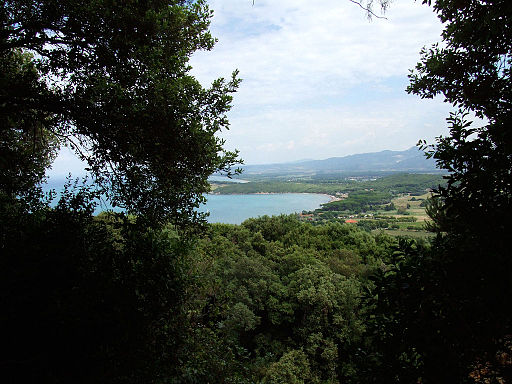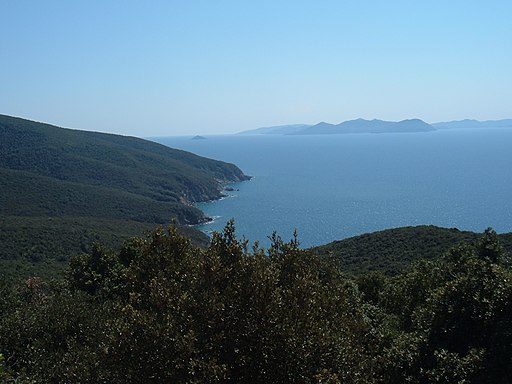| |
|
The Gulf of Baratti sits between the Ligurian Sea and the Tyrrhenian Sea to the north of the peninsula, which forms much of the town of Piombino. The basin lies between the promontory of Populonia and Torraccia, which is part of the municipality of San Vincenzo.
This small bay takes its name from the town of Baratti, located at the southern end, near which there are characteristic Etruscan burial mounds.
Baratti's location is ideal for tourists seeking a coastal retreat. It is included in the Archaeological Park of Baratti and Populonia and is one of the largest parks in the Val di Cornia. The influx of the archaeological tourist is secured not only by the presence of the Etruscan ruins but also because of the proximity of Populonia and its necropolis, which is reachable by a road that passes by Baratti.
Populonia, in ancient times was one of the largest and most important Etruscan and Roman cities. The ancient town is located in a dominant position on one of the promontories that form the Gulf of Baratti.
|
 |
The castle of Populonia [2]
|
| Baratti and Populonia Archeological Park
Stretching over 80 hectares between the slopes of the promontory of Piombino and the Gulf of Baratti, the Archaeological Park of Baratti and Populonia is presented as a real open-air museum, glittering with ferrous slag which show the impressiveness of the industrial Etruscan village. The Park includes a significant part of the ancient town of Populonia, a unique Etruscan settlement built directly on the sea, with its necropolises, the calcarenite quarries and the industrial working quarters for iron coming from the hematite deposits on the Island of Elba. The park is spread over various areas of visit which enable the visitor to appreciate the transformation of the scenery over the centuries.
|
 |
The Acropolis of Populonia (Piombino, Italy) seen from the nearby castle (
|
There are currently several proposed routes:
Necropoli di San Cerbone : the visit allows you to admire the oldest Etruscan tombs of Populonia (7th-5th century BC), including the great Tomba dei Carri.
Necropoli delle Grotte:the visit leads to the Etruscan quarries and chamber tombs (4th century BC) dug into the rock.
Acropoli di Populonia:
along the Via del Ferro starts an itinerary that leads up to the remains of the ancient walls of Populonia and then climbs up to the acropolis of the city, retracing an ancient paved road today hidden in the woods.. The heart of the ancient city of Populonia with houses, temples, baths and paved streets. In this area you can also observe the traces of the foundation of the city.
Monastero di San Quirico: the Middle Ages of Populonia are revealed through the remains of the Benedictine monastery of San Quirico, hidden in the woods.
Il Centro di archeologia sperimentale "Davide Mancini : in the lower part of the Park there is the Experimental Archeology Center, with the faithful reconstruction of a bronze age hut. Visitors to the Park, guided by experts, can personally experience the techniques of processing of antiquity. For school groups and groups, organized workshops are organized that address different issues of production and daily life.[3]
OPENING HOURS
March - June
and September - October:
from Tuesday to Sunday and holidays
from 10.00 to dusk
July August:
every day from 9.30am to 7.30pm
(extraordinary night openings)
|
|
|
|
| |
|
|
Mappa La Costa degli Etruschi | ll Golfo di Baratti e Populonia
|

Il Golfo di Baratti e Populonia | Photo Gallery
|
 |
|
 |
|
 |
| Golfo di Baratti, vista da Populonia |
|
Il golfo di Baratti, il porto di Baratti
|
|
Il golfo di Baratti, vista da Populonia |
 |
|
 |
|
 |
La Costa degli Etruschi, il golfo di Baratti
|
|
Golfo di Baratti
|
|
Golfo di Baratti, pineta
|
 |
|

|
|
 |
| Populonia, Necropoli delle Grotte |
|
Populonia, Necropoli di San Cerbone, tomba
|
|
Populonia, Acropolis |
 |
|
 |
|
 |
Via dei Cavalleggeri
|
|
Baratti, Capella San Cerbone |
|
Baratti, Capella San Cerbone |

[1] Foto di Przemek P, licenziato in base ai termini della licenza Creative Commons CC0 1.0 Universal Public Domain Dedication
[2] Source: I Parchi della Val Di Cornia: bellezza allo stato puro | The Archaeological Park of Baratti and Populonia
|
Golden light at Podere Santa Pia
|
|
|
 |
#poderesantapia Il nostro giardino. Insieme ai vigneti e agli uliveti, i cipressi sono l'elemento simbolo del paesaggio toscano
|
|
|















